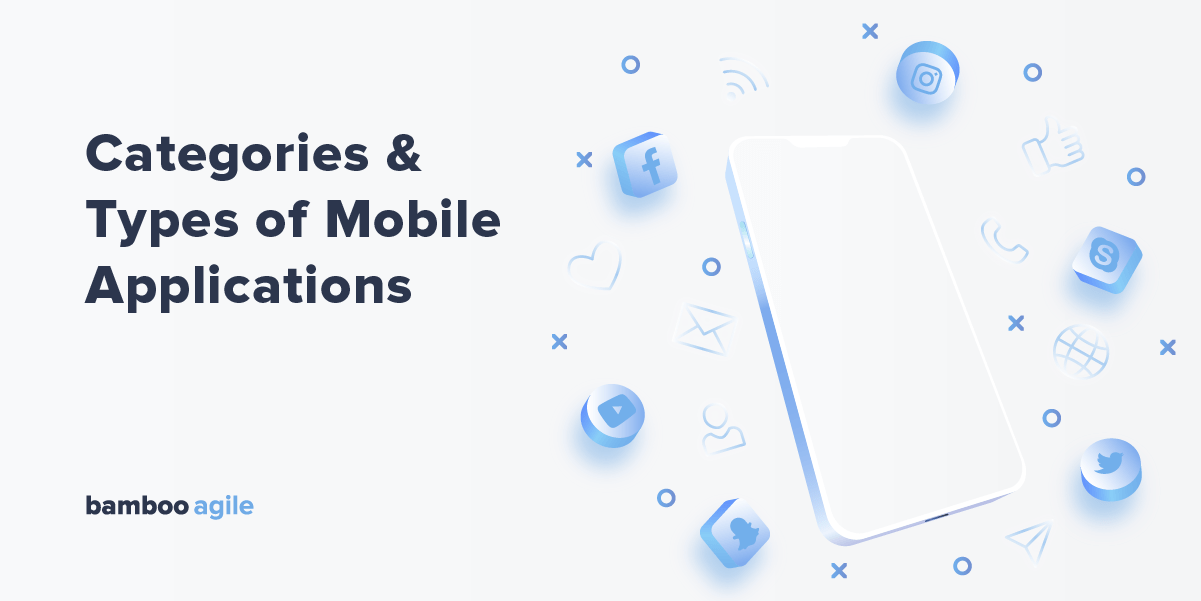Introduction
Smartphone apps have become an integral part of modern people’s lives. As the number of mobile devices grows, the need for application development also increases. Different types of mobile applications help us organise work and leisure time, find out the latest news, and communicate with our friends and family. New iOS and Android solutions appear on the market every day.
State of the mobile apps market
The mobile app market is still growing rapidly in 2023. According to Grand View Research, the global mobile application market has reached $206.85 billion in 2022 and is expected to grow at a CAGR of 13.8% from 2023 to 2030. This growth is being driven by the increasing number of smartphone users, the growing popularity of mobile commerce, and the increasing demand for mobile-friendly apps.
Some of the key trends in the market in 2023 include:
- The rise of mobile gaming: this is one of the fastest-growing segments of the market. In 2022, there were 142.6 billion apps downloaded, where 55.6 billion downloads were for games.
- The growth of mobile commerce: such sales in 2022 hit $415.93 billion—which represents 6.0% of total retail sales for the year and is expected to grow year by year.
- The increasing demand for mobile-friendly apps: More and more people are using their smartphones to access the internet. As a result, there is a growing demand for apps that are designed to be used on mobile devices.
These trends are creating new opportunities for businesses to reach and engage with their customers. By developing mobile apps that are relevant to their target audience, businesses can improve their customer experience and boost their bottom line.
Here are some of the top trends for 2023:
- Artificial intelligence (AI). AI is becoming increasingly prevalent in mobile apps, as developers look for ways to improve user experience and engagement. AI can be used for a variety of tasks, such as personalised recommendations, predictive analytics, and chatbots.
- Augmented reality (AR) and virtual reality (VR). AR and VR are still in their early stages of development, but they have the potential to revolutionise the mobile app market. AR and VR can be used to create immersive and interactive experiences that can’t be replicated on a traditional screen.
- 5G. 5G is the next generation of cellular network technology, and it promises to deliver much faster speeds and lower latency than 4G. This will enable new and innovative mobile apps that require high-bandwidth and low-latency connections.
- Privacy. As users become more concerned about their privacy, developers will need to find ways to collect and use data more responsibly. This could lead to new privacy-focused features and tools in mobile apps.
- Security. Mobile apps are a target for hackers, so developers need to take security seriously. This could lead to new security features and best practices in mobile application development.
These are just a few of the top mobile app trends for 2023. As the market continues to grow, we can expect to see even more innovative and exciting apps in the years to come.
Mobile apps categories
There are five main categories of mobile applications on the market. The choice of category depends on various parameters, such as timelines for development, budget, and some app specifications. Also, do not forget that the chosen category should meet the needs of your customers. Let’s take a closer look at these categories and find out the main differences between them all.
Native applications
These applications are called native because they are written in a programming language that is native to a particular platform. For Android, this language can be Java or Kotlin, while for iOS it is Objective-C or Swift.
Native applications are designed specifically for a certain platform and can use the full range of the device’s capabilities – camera, GPS sensor, accelerometer, compass, contact list, and so on. They can recognise standard gestures installed on the operating system by default or use completely new gestures unique to a particular solution. It’s worth saying that many native apps can work without an Internet connection.
Since native applications are optimised for a specific OS, they fit organically into any smartphone, meaning that their speed and performance stability remain the same no matter the device.
Native applications can have access to the device’s notification system, and, depending on the purpose of the native application, can completely or partially act without an Internet connection.
We’ve asked our iOS developer Alexey Gromov to share his thoughts about the state of the mobile development market and iOS development specifically. Here is what he shared with us:
“iOS development continues to move towards declarativeness, which allows you to write more elegant and compact code. The SwiftUI and Combine frameworks are still in constant, intensive development, with new elements being added and bugs getting fixed. Some developers and companies are still afraid to switch from UIKit to SwiftUI, fearing the dampness of the framework and bugs. But it’s worth it. SwiftUI brings a completely different level of emotion and enjoyment to the development process.”
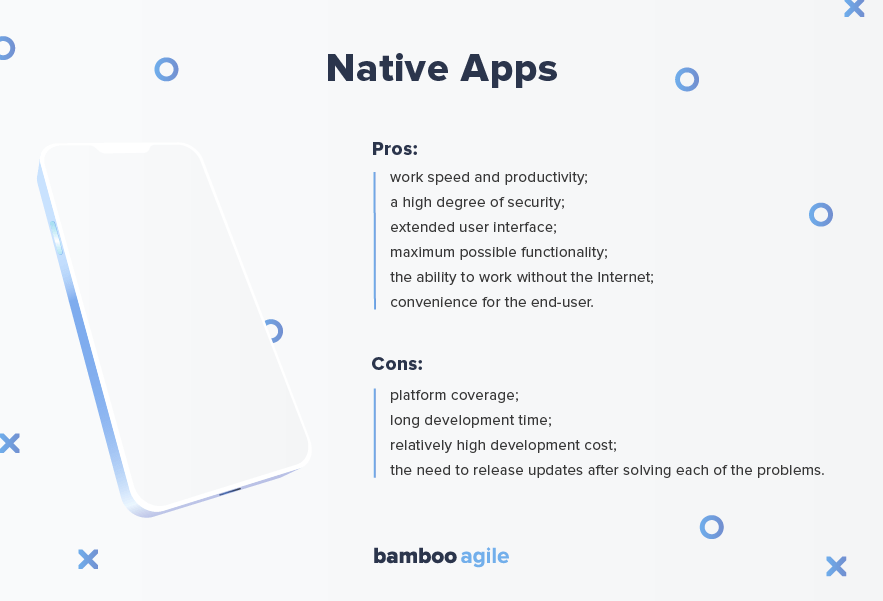
Mobile web applications
A mobile web application is essentially a website that is adapted and optimised for any smartphone. The only thing one needs to use is a browser, as well as an Internet connection.
There are several technologies that can be used for mobile web app development. The most common technologies include HTML/CSS, JavaScript, and frameworks such as Ionic, React Native, Flutter, and others.
When working with such solutions, users perform all the actions they perform when going to any website. They also get the opportunity to “install” these apps on their desktops by creating a bookmark of the webpage.
Mobile web applications are cross-platform, which means they can function independently of the device. Them not using device-specific software is their trump card. What’s more, since they are a mobile version of a site with enhanced interaction functions, web apps do not take up any storage space on the smartphone.
Web applications became widespread around the time HTML5 began to evolve and people realised that they could access much of the native app functionality through a regular browser. It’s difficult to say exactly where the clear boundary between mobile web applications and regular web pages lies since HTML5 is becoming more advanced by the day, and more and more sites choose to use it to its full extent.

Progressive Web Applications (PWA)
A progressive web app (PWA) is a web app that uses modern web technologies to provide an app-like experience to users. PWAs are installed on the user’s device and can be launched from the home screen, just like a native app. PWAs can also access offline content and push notifications, which makes them more engaging and useful for users than mobile web apps.
PWA development is performed by using technologies like HTML/CSS, Service Workers, Manifest, JavaScript, and frameworks (Angular, React, Ionic, Expo, etc.).
Even though PWA and mobile web applications have many similar features, such as web technologies usage, web browser access, and over-the-air updates, PWAs have something to offer their users. Unlike mobile web apps, PWAs can be installed on the user’s device. Another advantage is the ability to have access to offline content. There are also push notifications available and opportunities to make PWAs look and feel like native applications.

Hybrid applications
Hybrid applications are very similar to mobile apps but have their differences. Such apps are developed for different OSs at the same time in one programming language. As a result, it saves devs lots of headaches associated with developing separate app versions for every OS. In addition, like native apps, they require access to the device’s capabilities. But, unlike native applications, they need to have an Internet connection for stable work.
Hybrid apps are built using web technologies like HTML, CSS, and JavaScript, and then wrapped in a native container that allows them to be installed and run on mobile devices. Some of the commonly used technologies for developing hybrid apps include Apache Cordova, React Native, Ionic, Xamarin, Flutter, and others.
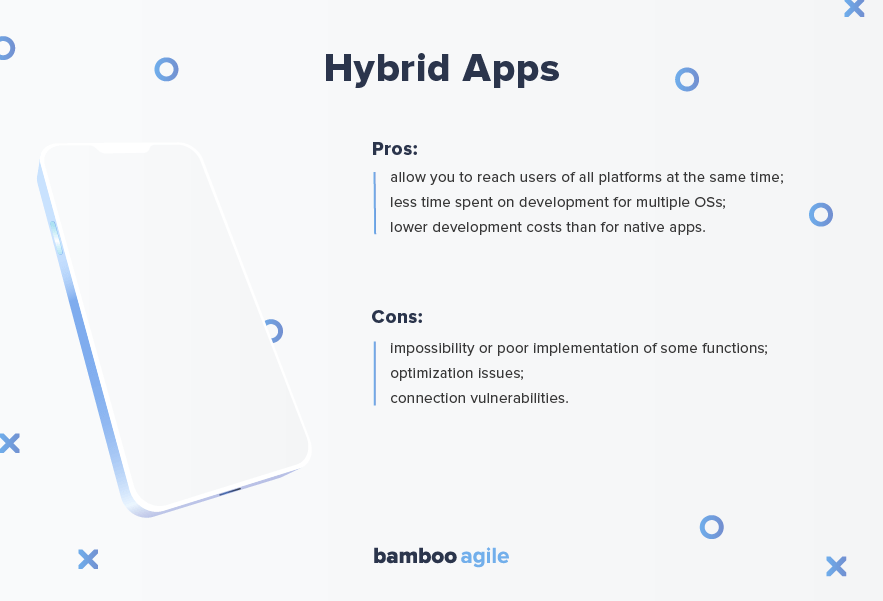
Cross-platform apps
A cross-platform app is a software application that can run on multiple platforms, such as iOS, Android, and Windows. Cross-platform apps are developed using a single codebase, which can save time and money on development.
Cross-platform app development can be done by using such technologies as HTML/CSS, LavaScript, and frameworks (Ionic, React Native, Flutter, Xamarin, etc.)
Many people may have problems distinguishing between cross-platform and hybrid applications. These applications undoubtedly have some similarities, like the ability to be used on multiple platforms, code reusability, native features, and the ability to be deployed through app stores. But there are differences between them.
Cross-platform apps are developed using a single codebase, while hybrid apps are developed using two codebases, one for each platform. Also, cross-platform apps may not be able to access all of the features of the platform, while hybrid apps can usually access all of the features of the platform. And hybrid and native apps can be more performant than cross-platform apps.
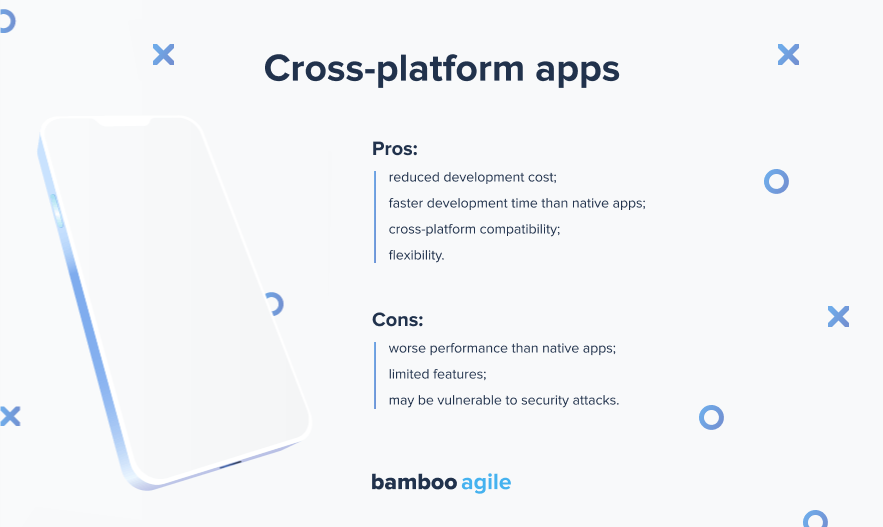
How to choose the right mobile app category?
If you are planning on making an app, you must decide what type of app you will create. Certain parameters will suit only one type of software but not others.
As you go through the following decision factors, answer the following question: what is the single most important aspect that affects your decision making today? The answer will determine which category you must concentrate on right now.
The app is needed as soon as possible
If you absolutely must have an app in the shortest amount of time, you should invest in developing a web app or PWA. Not only will using a single codebase reduce development time significantly, but it will also mean that your users already have what they need to use it: a mobile browser.
Resources are limited
If time and money are your main constraints, consider developing a web app or a hybrid app. The hybrid app allows you to test the market with a minimal viable product that can be in consumers’ hands within just a few months. If you are successful, you can subsequently opt to construct a full-fledged native version.
The app must be fast and stable
If performance is critical, then there is no way around it: you must create a native or cross-platform app. These types of apps will provide you with the speed, stability, and customisation elements that you require for your success.
There are a lot more criteria to compare various approaches to app development, so let’s have a quick look at them.

Mobile app types
At the moment, applications have firmly entered our lives. And there are a huge number of different types of mobile applications in the marketplace. Today, even companies that never needed apps before are going mobile. While some of them go out of their way to stay on top of the technology race and constantly improve their apps, many are simply meeting the basic customer demand for an app that makes their lives easier.
There are many types of applications that you can contribute to. Let’s talk about the most popular ones.
Lifestyle

Lifestyle apps are conquering the mobile app market because they streamline our daily routines. Such mobile applications help us find and improve people’s homes and offices, take up new hobbies, look good and feel good, remind us to go to the gym or drink the right amount of water, help us find our soulmate, etc.
Social Media
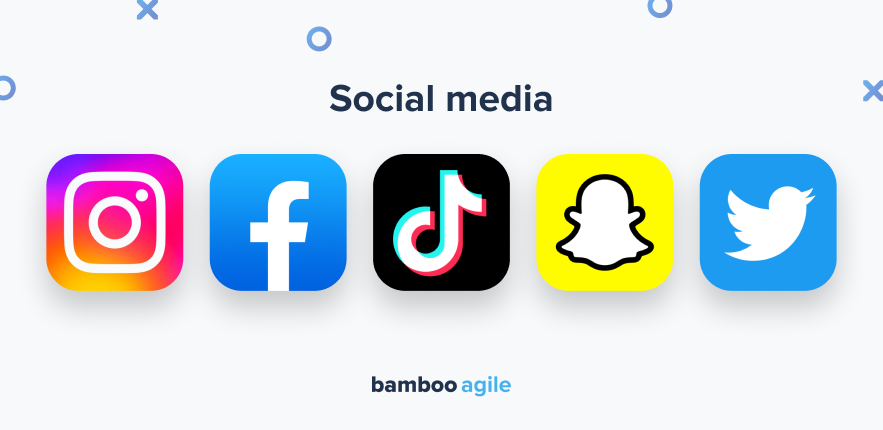
Social networks are a global trend that will not lose its relevance anytime soon. Messengers, business social networks, social media storages, directories, and corporate social networks are only a fraction of what the social media industry has to offer.
Utility
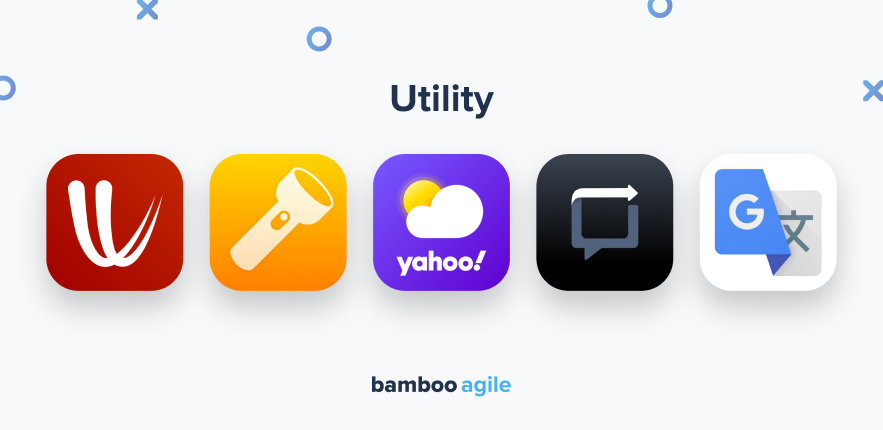
Utility applications are used almost every day and by almost every person. They exist to quickly satisfy certain needs. Examples of such applications are a calculator, an alarm clock, a QR scanner, or a flashlight.
Entertainment
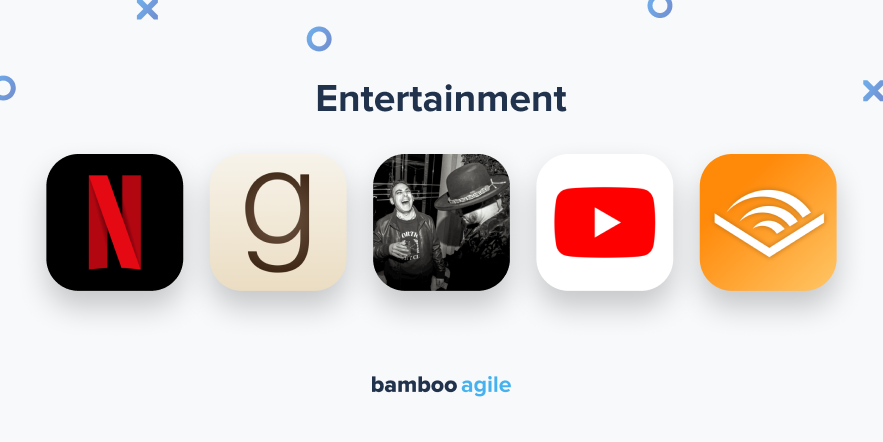
Nobody uses their smartphone for phone calls only – it’s also an extremely popular entertainment tool. There is a huge number of apps that are designed with this function in mind. Watching videos, reading books, and listening to music are only a small part of the services these solutions provide.
Productivity
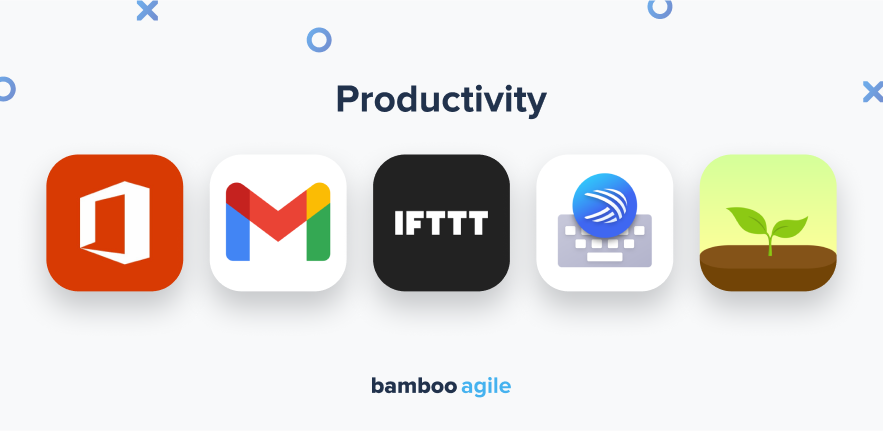
The purpose of these applications is to organise specific processes and tasks to make them more efficient and to save the user’s time and energy. Just like utility apps, they can be simple but very useful in everyday life. Among these applications, there are task managers, to-do lists, calendars, password managers, data viewers, email services, note creators, and cloud storage applications.
News and Magazines
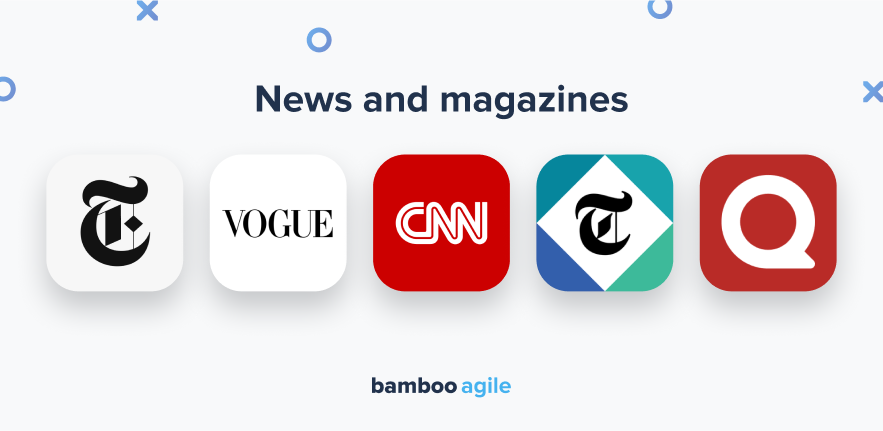
A smartphone allows you to be in the centre of all worldly events, as well as to stay informed on all the topics that are interesting to you specifically. A huge number of applications provide users with the opportunity to read various magazines and newspapers that cater to all possible interests.
Educational
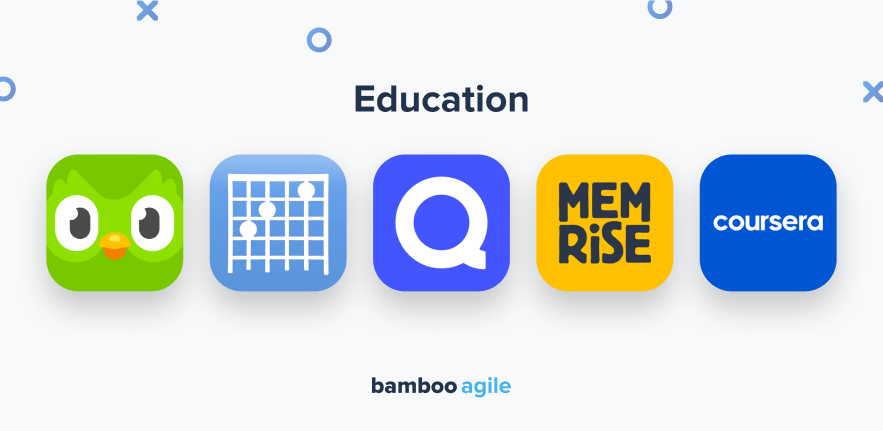
These days there are thousands of applications that help users learn anything from foreign languages to musical instruments – the choice is nearly limitless.
Games
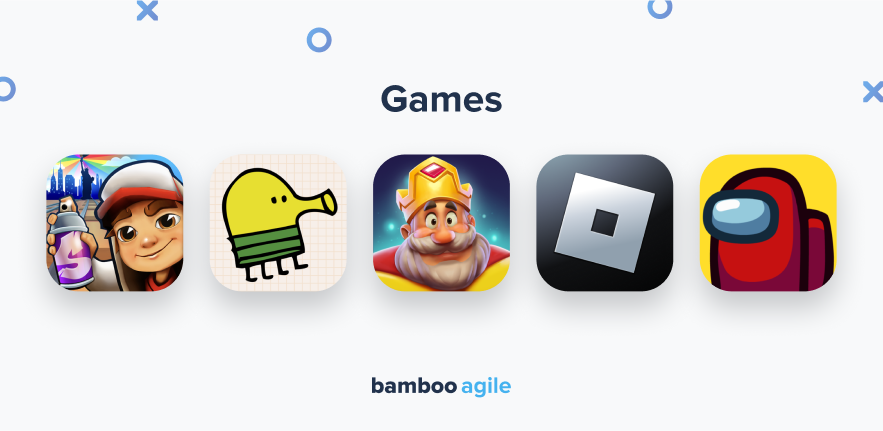
This type of app needs no description – every smartphone includes at least one simple game to pass the time by default.
Travel
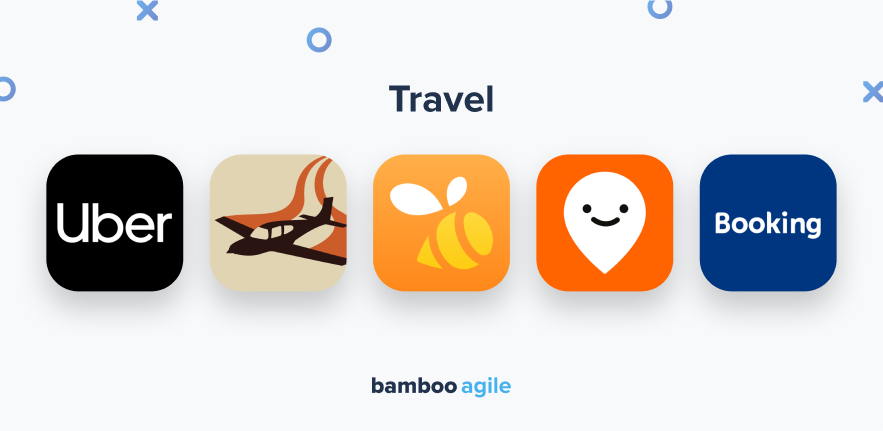
These applications can become a great assistant not only to those who travel the world but also to those who just need to find a way to a certain destination in their city. This can include online maps, taxi apps, apps for finding and booking tickets and apartments, and so on.
Food
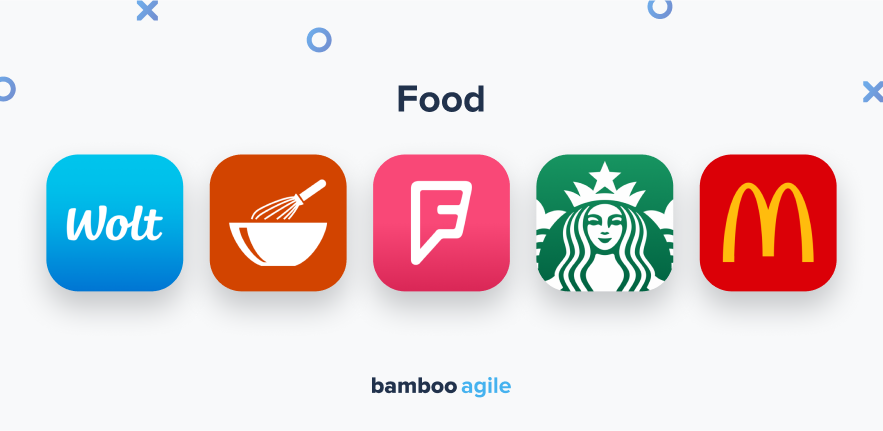
This type of application has become more popular than ever since the pandemic. Food ordering apps allow you to purchase food from various establishments, find interesting recipes, get cooking advice, and so on.
Finance
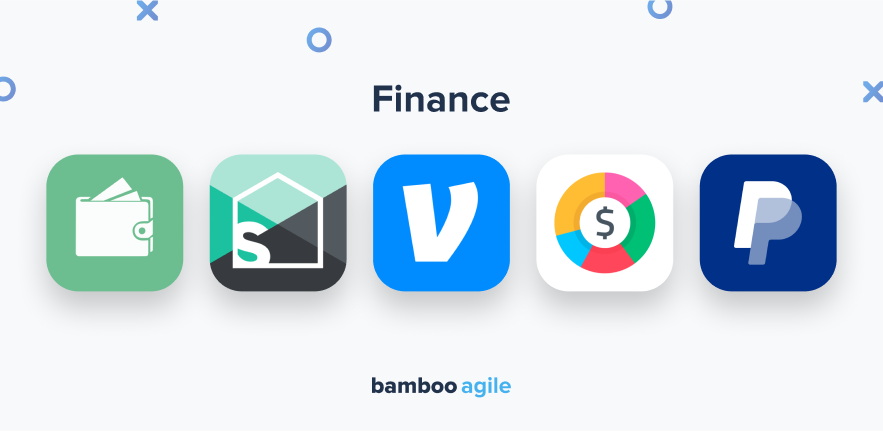
These applications help users effectively organise all their finances. Such apps include budget planners, trading tools, mobile banking, etc.
Photo and Video
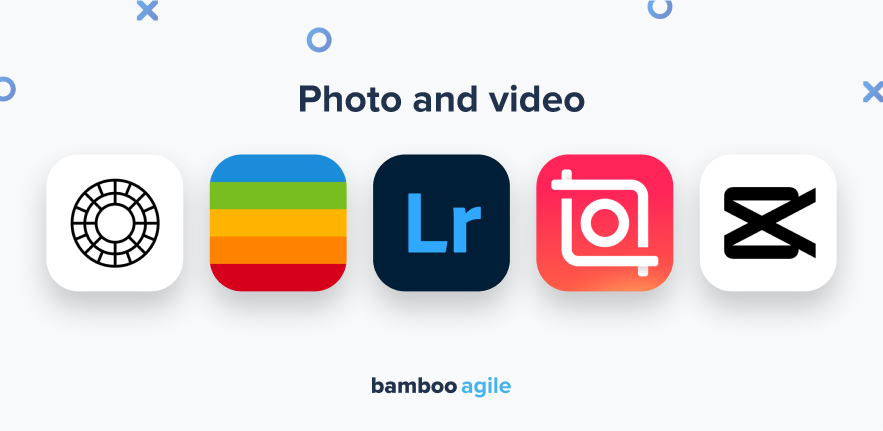
This type of application is a godsend to those actively involved in film and photography. These apps aggregate many different functions for editing photos and videos, allowing you to make little masterpieces of your own.
Shopping

These apps also gained more popularity during the pandemic, as they allow you to make purchases from the comfort of your home and without letting go of your smartphone. A huge selection of such applications allows you to purchase almost any goods one could need.
Conclusion
There is a massive number of applications available today, so much so that you can satisfy almost every basic need by just using your smartphone. With how many niches there are, there’s bound to be an audience for any application. Don’t hesitate, start looking for a team of professionals who can develop a perfect app for you!
Bamboo Agile is one such team of professionals. We create mobile applications by using the most renowned and powerful technologies in the mobile development industry. Contact us now by filling out the form on our website, and we will be happy to discuss your mobile application project!
